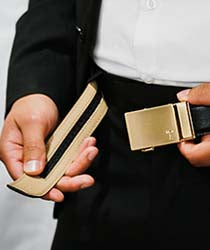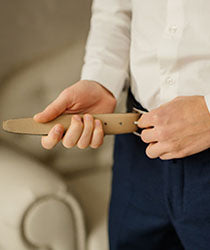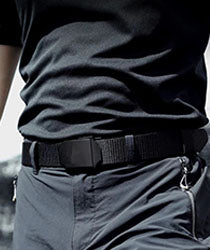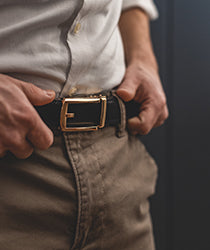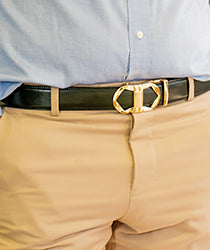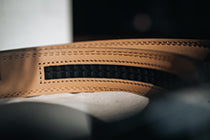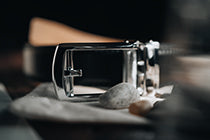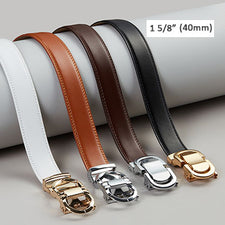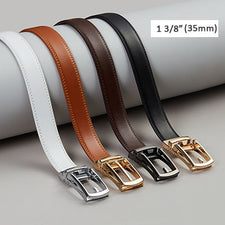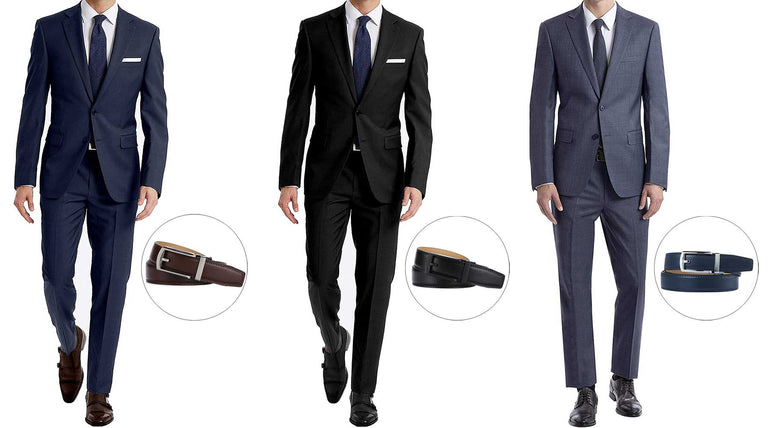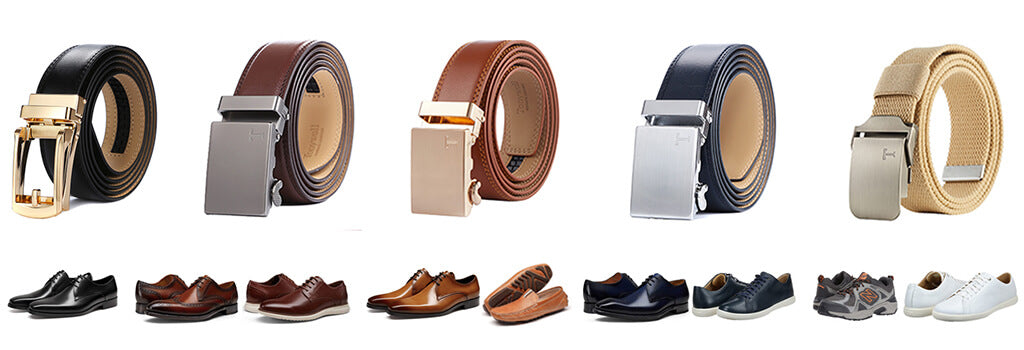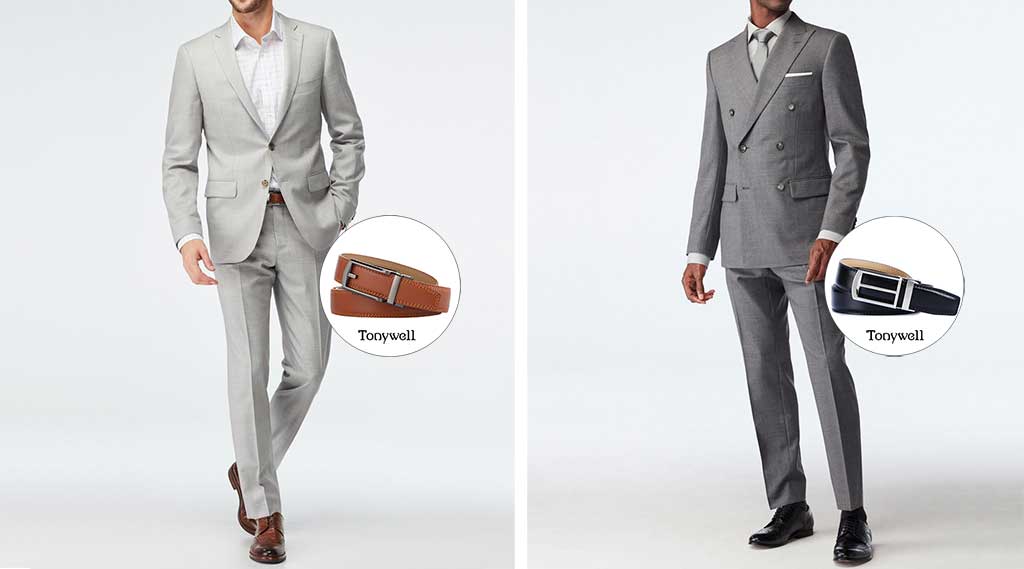A belt is more than just a functional accessory that holds up your pants or skirt. It's also an important element of your outfit that can make or break your overall look. Choosing the right belt to match your outfit can be tricky, but with a few tips and tricks, you can create a cohesive and stylish look.
Consider the color of your shoes
Matching a belt with shoes is an important aspect of dressing well. Here are some tips on how to match a belt with shoes:
1. Match the color:
One of the most important things to consider when matching a belt with shoes is the color. Generally, you should choose a belt that matches your shoes. For example, if you're wearing shades of brown shoes, choose a brown belt. If you're wearing black leather shoes, choose a black belt. If you're wearing white shoes, choose a white belt.
2. Match the finish:
In addition to color, you should also match the finish of the belt with the shoes. If you're wearing patent leather shoes, choose a belt with a shiny finish. If you're wearing suede shoes, choose a belt with a matte finish.
3. Consider the style:
The style of your shoes and belt should also complement each other. For example, if you're wearing dress shoes, choose a dress belt with a classic belt buckle. If you're wearing casual shoes, choose a more relaxed belt with a simple buckle.
4. Match the material:
The material of the belt and shoes should also match or complement each other. Choosing a leather belt to match your leather. If you're wearing canvas shoes, choose a canvas or fabric belt.
5. Don't be afraid to mix and match:
While it's important to match your belt and shoes, you can also experiment with different colors and textures to create a unique look. For example,can add a pop of color to a neutral outfit.
In conclusion, matching a belt with your outfit doesn't have to be a daunting task. In order to create a fashionable and unified outfit, one should think about choosing the right color of shoes, making sure they coordinate with their clothing, selecting the right type of metal, picking the right width, and considering how formal the event is. And remember, don't be afraid to experiment to find the perfect belt for your outfit.
Coordinate with your outfit
Matching a belt with your outfit goes beyond just matching the color of your shoes. Here are some tips on how to coordinate a belt with your outfit:
1. Consider the color palette:
When selecting a belt, consider the overall color palette of your outfit. If you're wearing a colorful outfit, choose a belt in a neutral color such as black or brown. If you're wearing a neutral outfit, consider a belt in a bright or bold color that adds a pop of color.
2. Match the formality of the occasion:
The formality of the occasion will determine the type of belt that you should wear. For example, a sleek leather belt is appropriate for formal occasions such as weddings, while a woven or braided belt is better suited for casual occasions.
3. Coordinate with accessories:
Your belt can also coordinate with other accessories that you're wearing, such as your watch or jewelry. For example, if you're wearing a gold watch and gold jewelry, consider wearing a belt with a gold buckle.
4. Match the texture:
The texture of your belt can also coordinate with your outfit. For example, if you're wearing a sweater with a knit texture, consider a belt with a woven texture.
5. Don't be afraid to mix and match:
While it's important to coordinate your belt with your outfit, don't be afraid to experiment with different colors, textures, and styles. A patterned belt, for example, can add interest to a plain outfit.
In conclusion, coordinating a belt with your outfit involves considering the color palette, the formality of the occasion, accessories, texture, and your personal style. By following these tips, you can create a cohesive and stylish look that complements your outfit. And remember, don't be afraid to mix and match to create a unique look that reflects your personality.
Match your metals
If you're wearing a belt with a metal buckle, it's important to make sure the metal matches any other metal accents in your outfit, such as jewelry or a watch. Matching the metal of your belt with the metal of your other accessories is an important aspect of coordinating your outfit. Here are some tips on how to match the metal of your belt with your other accessories:
1. Consider the color of your outfit:
If you're wearing an outfit with warm colors such as red, orange, or yellow, choose a belt with a warm metal tone such as gold. If you're wearing an outfit with cool colors such as blue, green, or purple, choose a belt with a cool metal tone such as silver.
2. Coordinate with your shoes:
When matching the metal of your belt with your shoes, consider the metal hardware on your shoes. For example, if your shoes have silver hardware, choose a belt with a silver buckle. If your shoes have gold hardware, choose a belt with a gold buckle.
3. Match the metal of your other accessories:
If you're wearing other metal accessories such as a watch, bracelet, or earrings, consider matching the metal of your belt with those accessories. For example, if you're wearing a gold watch, choose a belt with a gold buckle.
4. Mix metals in a deliberate way:
Mixing metals can be done in a deliberate way to create a fashion-forward look. For example, if you're wearing a silver belt, you can wear a gold watch and gold earrings for a mixed metal look.
5. Consider your personal style:
Ultimately, matching the metal of your belt with your other accessories should reflect your personal style. If you prefer a classic look, choose a belt with a metal tone that matches your other accessories. If you like to experiment with fashion, mix metals in a deliberate way.
In conclusion, matching the metal of your belt with your other accessories can enhance your overall outfit. You can create a fashionable and unified appearance that expresses your unique style by carefully choosing the color of your clothes, pairing them with shoes, combining different metals in a calculated manner, and matching the metals of your other accessories.
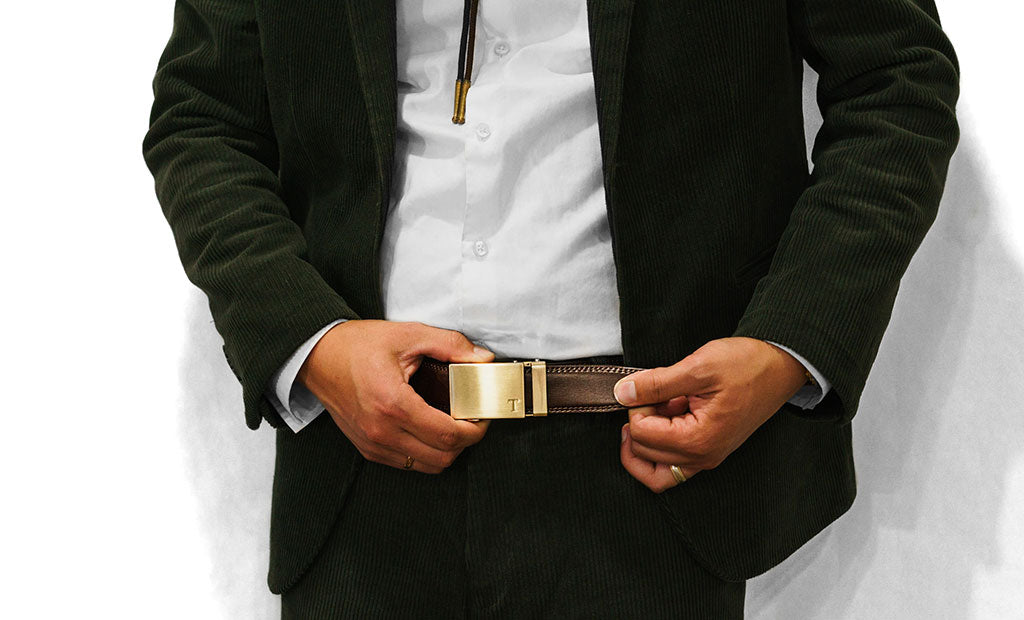
Choose the right width
Choosing the right width of the belt is important for both comfort and style. Here are some tips on how to choose the right width for a belt:
1. Consider the belt loops:
The width of the belt should match the width of the belt loops on your pants or skirt. If the loops are narrow, choose a narrow belt. If they are wider, choose a wider belt. Choosing a belt that's too wide or too narrow can throw off the balance of your outfit.
2. Consider your body type:
The width of your belt should be in proportion to your body type. If you have a smaller frame, choose a narrower belt. If you have a larger frame, choose a wider belt.
3. Consider the formality of the occasion:
The width of your belt can also vary depending on the formality of the occasion. A thinner belt is more appropriate for formal occasions, while a wider belt is better suited for casual occasions.
4. Coordinate with your outfit:
The width of your belt should also coordinate with your outfit. A thin belt can be paired with a dress or dress pants, while a wider belt can be worn with jeans or casual pants.
5. Consider the type of buckle:
The type of buckle can also influence the width of your belt. A wider buckle may require a wider belt to balance the look, while a smaller buckle can be paired with a narrower belt.
6. Personal preference:
Ultimately, the width of your belt should reflect your personal style and comfort level. If you prefer a more classic look, choose a belt with a traditional width. If you like to experiment with fashion, try a belt with a non-traditional width.
Consider the formality of the occasion
Considering the formality of the occasion is an important factor to consider when selecting a belt. Here are some tips on how to choose a belt based on the formality of the occasion:
1. Formal occasions:
For formal occasions such as weddings, black-tie events, or business meetings, it's best to choose a simple and understated belt. Look for a belt made of high-quality leather with a simple buckle. Avoid belts with bright colors, patterns, or bold designs, as they can be too casual for formal occasions.
2. Semi-formal occasions:
For semi-formal occasions such as dinners or parties, you can choose a belt that is slightly more casual than what you would wear for formal occasions. A leather belt with a simple design and a classic buckle is appropriate. You can also opt for a belt with a subtle pattern or texture to add a touch of personality.
3. Casual occasions:
For casual occasions such as weekends or outings, you have more freedom to experiment with different styles and designs. A belt with a bold pattern or a bright color can add a pop of interest to your outfit. You can also choose a belt made of materials other than leather, such as canvas or woven fabrics.
4. Work occasions:
For work occasions, the formality of the belt depends on the dress code of your workplace. If your workplace has a business casual outfit, a leather belt with a classic buckle is appropriate. If your workplace is more casual, you can choose a belt with a bit more personality or a unique design.
Don't be afraid to experiment
While matching your belt with your shoes is a safe choice, sometimes unexpected combinations can create a unique and stylish look. Don't be afraid to experiment with different colors, textures, and styles to find the perfect belt for your outfit. Fashion is a form of self-expression, and choosing a belt that reflects your personal style and taste can add a unique touch to your outfit.
Here are some tips on how to experiment with belts:
1. Mix and match colors:
Don't be afraid to mix and match colors. For example, wearing a suit in blue with a brown belt can create a stylish and unexpected contrast. You can also pair a colorful belt with a neutral outfit to add a pop of color.
2. Try different materials:
While leather is a classic choice for belts, you can also experiment with different materials such as canvas, woven fabrics, or even chains. A belt made of a unique material can add a distinctive and edgy touch to your outfit.
3. Play with patterns:
Belts with patterns, such as stripes, checks, or even animal prints, can add a playful and interesting touch to your outfit. Pairing a patterned belt with a solid color outfit can create a striking contrast.
4. Mix and match buckle styles:
Buckles come in different styles, such as square, round, or rectangular. Don't be afraid to mix and match buckle styles with different outfits. A unique buckle can add interesting detail to an otherwise simple outfit.
Conclusion
Matching a belt with your outfit doesn't have to be a daunting task. To create a fashionable and unified look, think about the color of your shoes, how they fit with your clothing, if the metals match, the width that works best, and how formal the event is. And remember, don't be afraid to experiment to find the perfect belt for your outfit.
Ready to dress sharp and command respect with the right accessory? Click here to discover Tonywell, the Professional Accessories Supplier.

